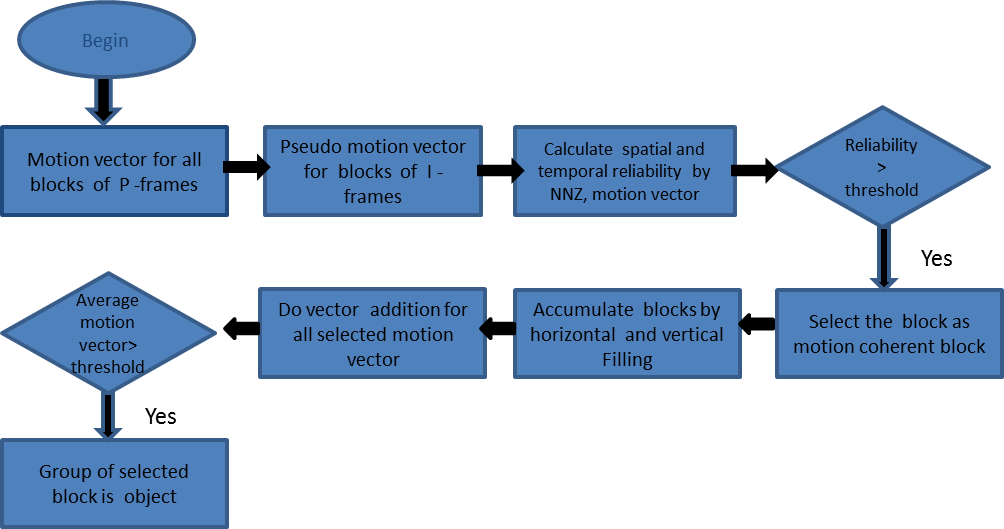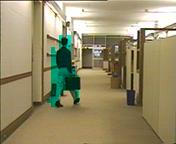About The Project
Title: Shot Based Video Watermarking For Very Low Bit Rate Video
Sponsoring Agency: Department of Science and Technology, Govt. of India (Fast Track)
Budget: Rs. 6.40 (in lakhs)
Principal Investigator: Dr. Arijit Sur
Technical Details
Digital Watermarking
Digital video watermarking is a technique which inserts a
digital signature into the video stream which can be extracted or computed to authenticate the
ownership of the media or the media itself.

Fig:1 Basic Watermarking Scheme
Objectives of the Project
The main objective of the proposed research work is to devise a robust compressed domain video
watermarking scheme without much degrading the watermarked video frames. For robust and visually imperceptible watermarking scheme, embedding zone selection is an important issue. Since selection of embedding zone usually
depends on spatial and temporal characteristics of the video sequence, efficient tracking of spatio-temporal distribution can be useful for efficient watermarking scheme.
Intuitively, inter-frame correlation and homogenous motion are usually higher within a video shot rather than a GOP.
The specific objectives of the project are as follows:
1. Finding suitable zone (blocks) for embedding in a video frame.
a.Efficient tracking of block motion within a shot of a video sequence.
b.Finding suitable blocks for embedding in a video frame exploiting spatial distribution of the frame.
2. Devise a video watermarking algorithm useful to the very low bit rate video sequence which
can resist different attacks such as collision and geometric attacks.
Part I: Embedding Zone Selection:
H.264/AVC, one of latest and most compressed the video coding standards chosen as low bit rate video format in this proposed scheme. Object base watermarking is resistance to geometric attacks and foreground object is very susceptible to HVS (Human Visual System). So watermark is embedded into object in motion. Different compressed domain parameter of video such as motion
vector, DCT coefficients of block, mode information have been used in detection performance. The algorithm briefly
described in Fig 2:
Object Detection Algorithm:
Input: Compressed video in H.264/AVC format
Output: Blocks of moving Object from Video for each frame

Fig:2 Object Detection
Part II: Watermark Embedding and Extraction:
The watermark logo is adaptive to shape and size of object. The logo is embedded by varying the
DCT coefficients of prediction error of H.264/AVC macro blocks. The watermark extraction procedure is non-blind.
Embedding Algorithm :
Input: Video to be watermarked, Watermarking Logo of object shape, Watermarking strength alpha
Output: Video with watermark embedded in DCT coefficient of object blocks

Fig:3 Embedding Algorithm
Extraction Algorithm:
Input: Original Video, Watermarked Video
Output: Watermark Logo

Fig:4 Extraction Algorithm
Results for Object Detection:
The object detection for different video using proposed scheme has been depicted below:

 ;
; 
Fig:5 Tennis Sequence Fig:6 Hall Monitor Sequence Fig:7 Claire Sequence
Comparison with most recent [8] low complexity algorithm for object
segmentation in H.264/AVC has been shown in table for Akiyo Video Sequence.

Table 1:
Results for Rotation Attack:
Visual Quality : A frame of watermarked video before embedding
and after embedding with watermarking strength 0.1 has been presented below.


Fig:8 Before Embedding
Fig:9 After Embedding
Robustness: Within a shot frame does not change much and
same watermark is embedded in each frame within a shot. Thus this scheme robust against collision attack.


Fig:9 Before Embedding
Fig:10 After Embedding
The correlation between embedded and extracted watermark from RST attacked video given in table 2
.

Table 2:
References:
[1]M. Noorkami and R. M. Mersereau, “A framework for robust watermarking
of H.264-encoded video with controllable detection performance,” IEEE Trans. Inf. Forensics Security, vol. 2, pp. 14–23, 2007.
[2] M. Noorkami and R. M. Mersereau, “Towards robust compressed-domain video watermarking for
h.264,” in Proc. Security, Steganography, and Watermarking of Multimedia Contents VIII, San Jose,
CA, 2006.
[3] M. Noorkami and R. M. Mersereau, “Digital video watermarking inP-frames with controlled video
bit-rate increase,” IEEE Trans. Inf. Forensics Security, Sep. 2008, vol. 3, no. 3, pp. 441–455.
[4]A. Mansouri, A. M. Aznaveh, F. Torkamani-Azar, and F. Kurugollu, “A low complexity video watermarking inH.264
compressed domain,” IEEE Trans. Inf. Forensics Secure. , pp. 649–657. 2010
[5]M. Swanson, B. Zhu, B. Chau, and A. Tewfik, “Object-based transparent
video watermarking,” in Multimedia Signal Processing, 1997., IEEE First Workshop on, 1997, pp. 369–374.
[6] M. Barni, F. Bartolini, and N. Checcacci, “Watermarking of mpeg-4 video objects,” Multimedia, IEEE
Transactions on, vol. 7,no. 1, pp. 23–32, 2005
[7] L. Wang, H. Ling, F. Zou, and Z. Lu, “Real-time compressed domain
video watermarking resistance to geometric distortions,”MultiMedia, IEEE, vol. 19, no. 1, pp. 70–79, 2012
[8] L. Sun, M. Dai, and X. Chen, “A simple and fast moving object segmentation based on h.264 compressed domain information,” in Computational and Information Sciences (ICCIS), 2012 Fourth
International Conference on, aug. 2012, pp. 481 –484





 ;
; 





